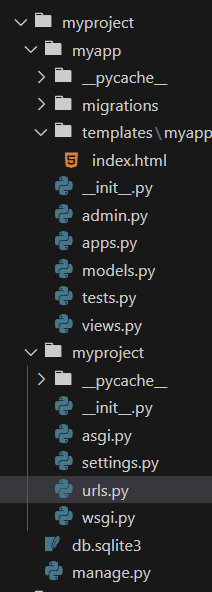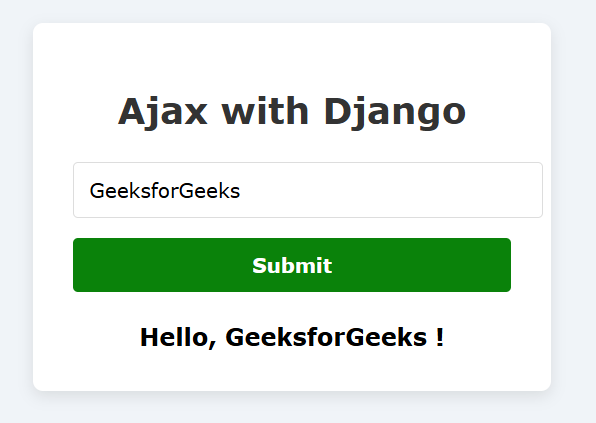How To Integrate Ajax with Django Applications
Last Updated : 05 Aug, 2025
Django is one of the most popular web frameworks for building robust and scalable web applications. However, many modern applications require asynchronous features, enabling real-time interactions without the need to reload the entire page. This is where Ajax (Asynchronous JavaScript and XML) comes into play. By integrating Ajax with Django, we can create dynamic web applications that provide a smooth user experience. In this article, we’ll walk through the steps of integrating Ajax into a Django project.
What is Ajax?
Ajax is a technology that allows web pages to be updated asynchronously by exchanging small amounts of data with the server behind the scenes. This means that parts of the web page can be updated without requiring a full reload. It uses a combination of:
- JavaScript to make asynchronous requests to the server.
- XMLHttpRequest (XHR) or the newer Fetch API for server requests.
- JSON or XML for data transfer (though JSON is more common today).
The result is a more responsive and seamless web application, offering improved user experience and performance.
Integrate Ajax with Django Applications
Step 1: Setting Up a Django Project
First, let's create a new Django project and app:
django-admin startproject myproject
cd myproject
python manage.py startapp myapp
Add the app to settings.py in the project folder:
Python # Inside myproject/settings.py INSTALLED_APPS = [ # Django default apps... 'myapp', ]
 Django Project Structure
Django Project StructureRun initial migrations:
python manage.py migrate
Step 2: Creating Views and Templates
Now that the project is set up, let’s create a basic template and view to demonstrate Ajax functionality.
1. Create a View in views.py (Inside the myapp folder):
Python from django.http import JsonResponse from django.shortcuts import render # Standard view to render the page with the form def index(request): return render(request, 'myapp/index.html') # View to handle the Ajax request def ajax_view(request): if request.method == 'POST': name = request.POST.get('name') message = f'Hello, {name}!' return JsonResponse({'message': message}) return JsonResponse({'message': 'Invalid request'}) 2. Create a Template in templates/myapp/index.html:
HTML <!DOCTYPE html> <html lang="en"> <head> <meta charset="UTF-8"> <meta name="viewport" content="width=device-width, initial-scale=1.0"> <title>Ajax with Django</title> <script src="https://code.jquery.com/jquery-3.6.0.min.js"></script> <style> /* General body styling */ body { font-family: 'Arial', sans-serif; background-color: #f0f4f8; margin: 0; padding: 0; display: flex; justify-content: center; align-items: center; height: 100vh; } /* Center the main container and set its width */ .container { background-color: #ffffff; padding: 2rem; border-radius: 8px; box-shadow: 0 4px 12px rgba(0, 0, 0, 0.1); width: 350px; text-align: center; } h1 { color: #333; margin-bottom: 1.5rem; font-size: 1.8rem; font-family: Verdana, Geneva, Tahoma, sans-serif } /* Style for form input */ input[type="text"] { width: 100%; padding: 0.75rem; font-size: 1rem; border: 1px solid #ddd; border-radius: 4px; margin-bottom: 1rem; font-family: Verdana, Geneva, Tahoma, sans-serif; outline: none; transition: border-color 0.3s ease; } input[type="text"]:focus { border-color: #007bff; } /* Styling for submit button */ button[type="submit"] { width: 100%; background-color: rgb(10, 130, 10); color: #fff; padding: 0.75rem; font-size: 1rem; font-weight: bold; font-family: Verdana, Geneva, Tahoma, sans-serif; border: none; border-radius: 4px; cursor: pointer; transition: background-color 0.3s ease; } /* Style for displaying the response message */ #responseMessage { margin-top: 1.5rem; font-size: 1.2rem; color: black; font-weight: bold; font-family: Verdana, Geneva, Tahoma, sans-serif; } /* Subtle animations */ input[type="text"], button[type="submit"] { transition: all 0.3s ease; } /* Responsiveness */ @media (max-width: 768px) { .container { width: 90%; } } </style> </head> <body> <div class="container"> <h1>Ajax with Django</h1> <form id="myForm"> <input type="text" id="nameInput" name="name" placeholder="Enter your name"> <button type="submit">Submit</button> </form> <div id="responseMessage"></div> </div> <script> // Ajax setup for form submission $(document).ready(function() { $('#myForm').on('submit', function(event) { event.preventDefault(); $.ajax({ url: '/ajax/', // The URL of the Django view that handles the request type: 'POST', data: { 'name': $('#nameInput').val(), 'csrfmiddlewaretoken': '{{ csrf_token }}' // CSRF token for security }, success: function(response) { $('#responseMessage').text(response.message); // Update the page dynamically } }); }); }); </script> </body> </html>
3. Add URL Patterns in urls.py:
Python from django.contrib import admin from django.urls import path from myapp import views urlpatterns = [ path('admin/', admin.site.urls), path('', views.index, name='index'), path('ajax/', views.ajax_view, name='ajax_view'), ] Step 3: Run and Test the Application
After completing the above steps, start the Django server again if it’s not running:
python manage.py runserver
Navigate to http://127.0.0.1:8000/ in the browser, and we'll see a simple form. Enter a name in the input field and click Submit. Without reloading the page, the form will send the data to the server, and the response will be displayed below the form in real time.
 Integrate Ajax with Django Applications
Integrate Ajax with Django ApplicationsAdvantages of Integrating Ajax with Django
- Improved User Experience: Ajax allows you to update parts of a webpage without requiring a full page reload, which makes the user interface faster and more interactive.
- Reduced Bandwidth Usage: Since only small parts of the webpage are reloaded, the overall data transfer between the client and the server is minimized, improving performance.
- Real-time Updates: Ajax can be used to fetch data from the server in real-time, making it suitable for live content updates (e.g., live chat, notifications).
- Improved Performance: By updating only necessary parts of the page, the overall load on both the server and the client is reduced, resulting in faster application performance.
Conclusion
Integrating Ajax with Django is a powerful way to make your web applications more interactive and efficient. In this article, we’ve demonstrated how to set up a basic Django project, create an Ajax-powered form, and handle real-time updates without reloading the entire page. This method provides a smoother user experience, making your application more responsive and modern.
Explore
Python Fundamentals
Python Data Structures
Advanced Python
Data Science with Python
Web Development with Python
Python Practice
My Profile